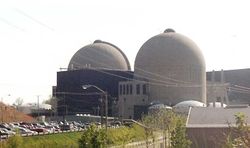Reactor building

Reactor buildings are used for containment of nuclear reactors and many components of a nuclear power plant, to ensure maximum safety in operation and in the event of an accident. The construction of these buildings requires they be extremely strong, and are often made of thick, reinforced concrete or steel walls and roofs.[2][3] The containment structure of a reactor building must achieve the following safety functions:[3]
- Confinement of radioactive substances during operation and in the case of an accident
- Protection of the plant against natural disasters and human induced events
- Radiation shielding during operation and in the event of an accident
The buildings must be accessible during normal operation, so they are kept at "negative pressure" meaning that when an operator enters the containment structure, air will flow into the structure rather than out.[2] Therefore, even in the event of a nuclear release inside the building, an uncontrolled release to the environment is quite unlikely. The operator can enter through an airlock chamber, which has two doors to ensure that the interior of the building is never exposed to the outside air.[2]
Safety measures
The main goal of these structures is to envelop the interiors of a nuclear power plant, thus isolating the environment and all life outside from the radiation inside. The structural integrity of these buildings is strictly monitored and tested, and they must meet leak requirements in the case of an accident. The containment systems provide shielding of neutrons and gamma decay particles in the event that they leak from the core, and the building itself is often backed-up by many other safety measures such as ventilation, cooling systems, shutdown systems, and more.[3]
These safety systems must be able to relieve high temperatures and pressures in the event of an emergency shutdown. Therefore, they must be able to withstand extremely high thermal and mechanically induced loads, pressures, and extreme weather events.[3] The video below shows an airplane going at top speed into the wall of a containment building. This dramatic test gives an idea on how strong these buildings are.
Internal failures that must be addressed include:[3]
- Loss of coolant accidents (LOCA),
- Breaks in steam or feedwater piping,
- Fires or flooding,
- Ruptured pressure tubes in pressurized water reactors,
- Fuel handling accidents,
- etc
External events that must be addressed range from earthquakes to tsunamis to volcanic eruptions. Even aircraft crashes as seen in the video above are of potential concern.
Codes and standards have been developed by various national and international organizations, covering all areas of construction (materials, manufacturing, design), maintenance (inspection and testing), and quality assurance.[3]
For Further Reading
- Reactor types
- Nuclear power plant
- Nuclear power
- Energy from nuclei
- Loss of coolant accident
- Or explore a random page
References
- ↑ Wikimedia Commons [Online], Available: https://commons.wikimedia.org/wiki/File:Donald_Cook_Nuclear_Power_Plant_1993.jpg
- ↑ 2.0 2.1 2.2 McMaster Nuclear Reactor. (June 26 2015). Structural Features [Online], Available: http://mnr.mcmaster.ca/overview/reactor-operations-sp-688/structural-features.html
- ↑ 3.0 3.1 3.2 3.3 3.4 3.5 IAEA Safety Standard Series. (June 26 2015). Design of Reactor Containment Systems for Nuclear Power Plants [Online], Available: http://www-pub.iaea.org/MTCD/publications/PDF/Pub1189_web.pdf

